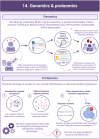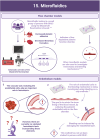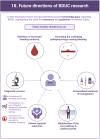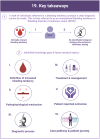Bleeding disorder of unknown cause: an illustrated review on current practice, knowledge gaps, and future perspectives
- PMID: 39687924
- PMCID: PMC11648783
- DOI: 10.1016/j.rpth.2024.102625
Bleeding disorder of unknown cause: an illustrated review on current practice, knowledge gaps, and future perspectives
Abstract
In more than half of the individuals with a clinically relevant bleeding tendency who are referred to hemostasis experts, no biological etiology can be found after extensive laboratory testing. These persons are diagnosed with an unexplained bleeding tendency or "bleeding disorder of unknown cause" (BDUC). The mucocutaneous bleeding phenotype of individuals with BDUC is generally comparable to that of individuals with inherited bleeding disorders such as von Willebrand disease or platelet function disorders. BDUC definitions applied in literature are heterogeneous, but all comprise 2 main criteria: (1) there is an increased bleeding tendency based on the clinical view of the physician and/or an increased bleeding score; (2) no abnormalities are found with available hemostasis laboratory tests. This is reflected in the recent published BDUC definition by the Scientific and Standardization Committee of the International Society on Thrombosis and Haemostasis, stating that BDUC is a diagnosis of exclusion, characterized by normal hemostatic investigations despite a clinically significant bleeding tendency. Importantly, other nonhemostatic and acquired causes of bleeding should be excluded, but details on exclusion criteria and associated diagnostic testing remain undefined. Patients and health care providers are challenged by the uncertainty and lack of formal diagnosis particularly as there is no clear consensus regarding treatment. Research on the diagnostic value of new laboratory tests in individuals with BDUC has not yet been productive. In this illustrative review, the current practice and knowledge gaps in BDUC are addressed, previous research on BDUC is outlined and future directions with outstanding questions for future research in BDUC are highlighted.
Keywords: bleeding disorder of unknown cause; diagnosis; hemostasis; review; treatment.
© 2024 The Authors.
References
-
- Thomas W., Downes K., Desborough M.J.R. Bleeding of unknown cause and unclassified bleeding disorders; diagnosis, pathophysiology and management. Haemophilia. 2020;26:946–957. - PubMed
-
- Baker R.I., Choi P., Curry N., Gebhart J., Gomez K., Henskens Y., et al. Standardization of definition and management for bleeding disorder of unknown cause: communication from the SSC of the ISTH. J Thromb Haemost. 2024;22:2059–2070. - PubMed
-
- Gebhart J., Hofer S., Panzer S., Quehenberger P., Sunder-Plassmann R., Hoermann G., et al. High proportion of patients with bleeding of unknown cause in persons with a mild-to-moderate bleeding tendency: results from the Vienna Bleeding Biobank (VIBB) Haemophilia. 2018;24:405–413. - PubMed
-
- Quiroga T., Goycoolea M., Panes O., Aranda E., Martinez C., Belmont S., et al. High prevalence of bleeders of unknown cause among patients with inherited mucocutaneous bleeding. A prospective study of 280 patients and 299 controls. Haematologica. 2007;92:357–365. - PubMed
-
- MacDonald S., Wright A., Beuche F., Downes K., Besser M., Symington E., et al. Characterization of a large cohort of patients with unclassified bleeding disorder; clinical features, management of haemostatic challenges and use of global haemostatic assessment with proposed recommendations for diagnosis and treatment. Int J Lab Hematol. 2020;42:116–125. - PubMed
LinkOut - more resources
Full Text Sources




















